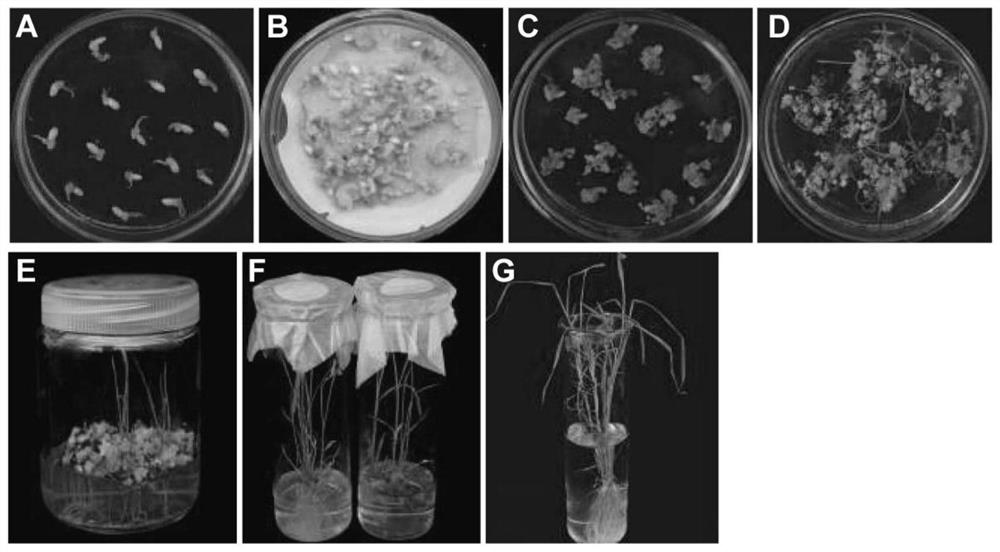Application of wild barley hscipk17 on the Qinghai-Tibet Plateau in improving rice resistance/tolerance to abiotic stress
A wild and barley technology, applied in the field of plant genetic engineering, can solve problems such as lack of notification, and achieve the effects of enhancing growth and development, good application prospects, and promoting growth and development
- Summary
- Abstract
- Description
- Claims
- Application Information
AI Technical Summary
Problems solved by technology
Method used
Image
Examples
Embodiment 1
[0088] Embodiment 1, seed germination and cultivation
[0089] The annual wild barley X74 (Hordeum spontaneum C.Koch) and rice Nipponbare (Oryza sativa L.ssp.japonica) seeds on the Qinghai-Tibet Plateau were surface-sterilized with 70% ethanol for 10 minutes, followed by 10% NaClO for 30 minutes, and finally rinsed with water for 8 times . The endosperm of barley and rice grains contains a large amount of nutrients, which is sufficient to meet the nutritional needs of grain germination within a week. Therefore, a simple CaCl 2 solution (0.1mM CaCl 2 ; pH 5.8) for barley and rice seed germination and seedling growth. In the dark at 25°C, sterile barley seeds were placed in CaCl 2 After one day of germination between two layers of filter paper soaked in the solution, the seeds were transferred to a new CaCl 2 The incubation was continued for 4 days on solution-soaked absorbent cotton filter paper (dark 25°C). Rice seeds were treated in the dark (4°C) for 3 days, then germi...
Embodiment 2
[0090] Embodiment 2, the cloning of HsCIPK17 gene of annual wild barley of Qinghai-Tibet Plateau
[0091] (1) Two methods used for electronic cloning of HsCIPK17. First, the known rice OsCIPK1 to OsCIPK31 ( http: / / www.ncbi.nlm.nih.gov / ; OsCIPK cDNAs gene accession numbers are as follows) full-length cDNAs as probes, search for homologous genes in barley (Hordeum vulgare L.) full-length cDNA library ( http: / / earth.lab.nig.ac.jp / ~ dclust / cgi-bin / barley_pub / ). Secondly, the conserved sequence activation loop and NAF / FISL motifs in the rice OsCIPK1 to OsCIPK31 full-length cDNAs used as probes were compared with the barley nucleotide collection (nr / nt) database ( http: / / blast.ncbi.nlm.nih.gov / ) to perform BLAST alignment of homologous fragment sequences, and perform electronic assembly and extension. Finally, the resulting full-length cDNA was analyzed with DNA STAR SeqMan and Megalign software.
[0092] OsCIPK1-OsCIPK31 cDNAs NICB Genbank accession number
[0093] ...
Embodiment 3
[0096] Example 3, Construction of the transgenic 35S::HsCIPK17 vector of the HsCIPK17 gene
[0097] 35S::HsCIPK17 ( figure 1 ). pCAMBIA2300S contains 2×CaMV 35S promoter and kanamycin resistance marker. The vector is used for the overexpression of HsCIPK17 gene in rice. Using cDNA as a template, use HsCIPK17-specific primers (Table 1) to amplify the corresponding HsCIPK17 target fragment. The PCR amplification system (50 μL system) is as follows: PCR H 2 O 17.5 μL, 2×PrimerSTAR GCBuffer 25 μL, PrimerSTAR HS DNA Polymerse 0.5 μL, dNTP mixture 4 μL, Primer F 1 μL, Primer R 1 μL, cDNA 1 μL. The PCR amplification program was as follows: pre-denaturation at 94°C for 3min, denaturation at 98°C for 10s, annealing at 65°C for 5s, extension at 72°C for 1min, 35 cycles, extension at 72°C for 10min, and storage at 16°C. Then, the target fragment was connected to the carrier through molecular cloning operations such as purification (recovery from gel cutting), enzyme digestion, and li...
PUM
 Login to View More
Login to View More Abstract
Description
Claims
Application Information
 Login to View More
Login to View More - R&D
- Intellectual Property
- Life Sciences
- Materials
- Tech Scout
- Unparalleled Data Quality
- Higher Quality Content
- 60% Fewer Hallucinations
Browse by: Latest US Patents, China's latest patents, Technical Efficacy Thesaurus, Application Domain, Technology Topic, Popular Technical Reports.
© 2025 PatSnap. All rights reserved.Legal|Privacy policy|Modern Slavery Act Transparency Statement|Sitemap|About US| Contact US: help@patsnap.com



